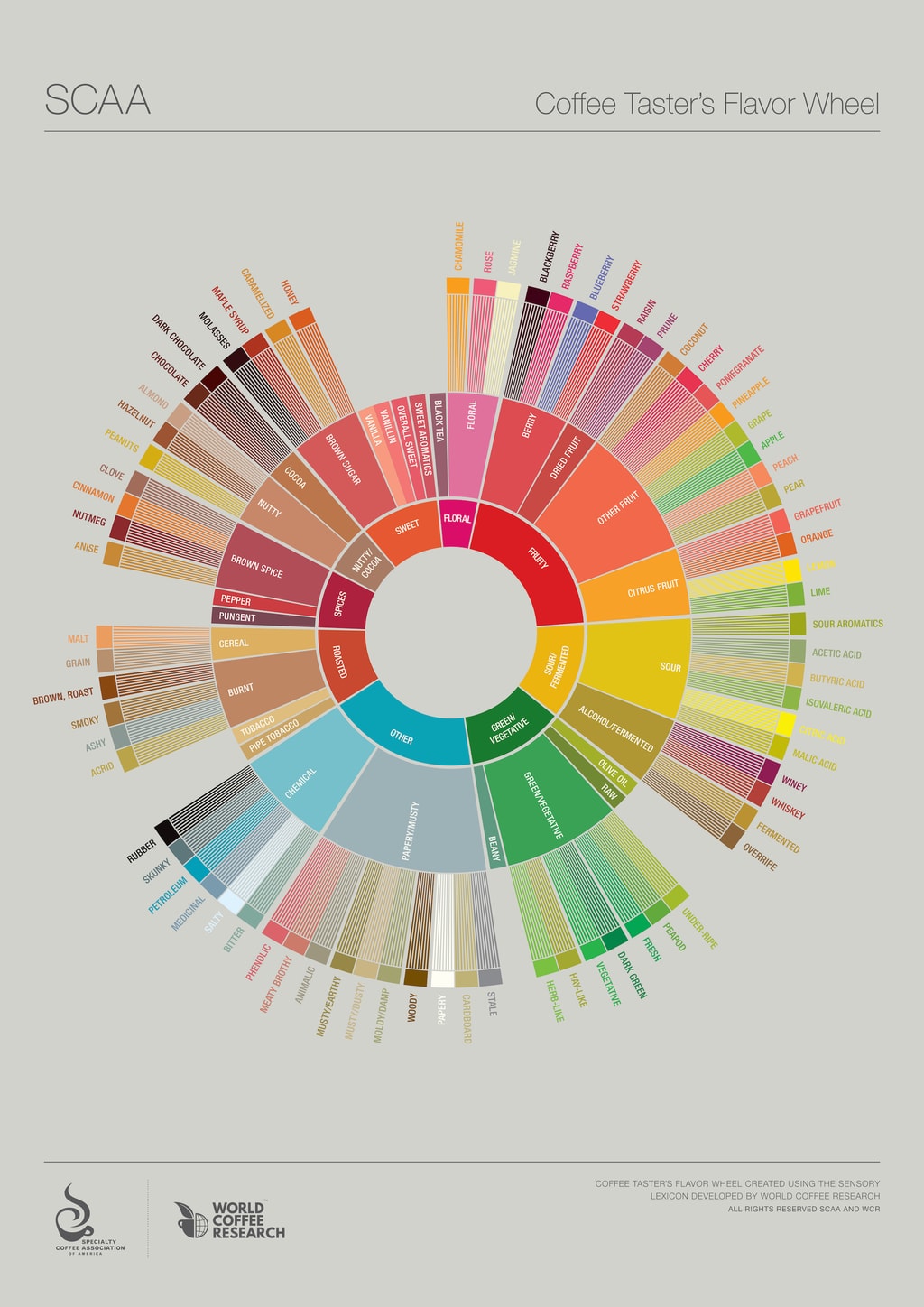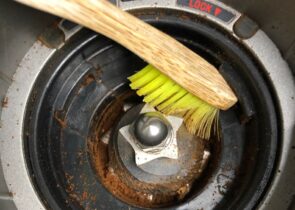It can be intimidating to get into coffee when faced with a huge variety of options. Then the experience turns to disappointment when what you taste doesn’t match up with what’s on the bag. What on earth does “honeysuckle” taste like, anyway?
If you want to learn how to taste coffee like a professional, then we can certainly help with that.
“But this coffee just tastes like coffee!” In my 10 years of training baristas and hosting tastings for clients, I’ve heard novice tasters say this a lot. Trust me — I wasn’t born with this ability either, so I know first-hand that you can get there!
You do have to learn concepts about coffee and tasting, and then repeatedly practice on lots of coffee. But stick to it, and you’ll be rewarded with a deeper understanding and appreciation of coffee flavor.

Understand What Influences Coffee Flavor
There’s a basis for a coffee’s tasting notes, believe it or not. Coffee, quite simply, is the most complex beverage in the world, containing more than a thousand aromatic compounds, which appear in coffee as flavors of fruit, chocolate, flowers, and many more.
Not all of those compounds make it to your cup of joe, but that’s what makes every coffee different. There are several factors in the coffee’s life cycle that mold and shape the quality of its final taste profile. These are:
Coffee Origin
In winemaking, the word ‘terroir’ refers to distinctive flavor characteristics imparted to grapes by the environment where it was grown and produced.
The same is true for coffee, where each element of its geographical location affects flavor differently.
Soil
Terroir means ‘soil’, and that alone should tell you how important this is!
Sufficient amounts of soil minerals such as nitrogen, phosphorous, and potassium are essential for healthy plants and bountiful harvests.
Large amounts of certain minerals also directly affect flavor formation. High amounts of potassium, for instance, increase a coffee’s levels of citric acidity, which can make coffee taste like lemon or lime. An excess of phosphorous increases a coffee’s phosphoric acid content, which can make coffee taste like grape or raspberry.
Something I learned from a coffee producer I’ve worked with, is that the presence of bacteria in the soil also promotes better flavor complexity in the final product.
Microbes act as recyclers, converting insoluble materials in the soil into nutritious, energy-rich compounds that are great for plant growth and productivity. Another reason for coffee farmers to avoid pesticide use!
Climate
Coffee is most productive as a crop in tropical and sub-tropical areas above and below the equator, often dubbed ‘The Coffee Belt’. In this area, there are often only two seasons — wet and dry.
The rainy season acts as crop irrigation and aids in the absorption of nutrients from the soil.
The dry season, on the other hand, provides an opportunity for farmers to harvest and process the coffee fruit. It also acts as a signal for the plants to begin growing flowers right as the season ends.
Altitude
If you’ve experienced hiking up a mountain, you may have noticed more frequent rains and much cooler nights.
Low temperatures cause the coffee fruit to mature slower, which increases flavor complexity and sugar development.
In most cases, this means quality. For instance, Ethiopian coffees that are grown upwards of 1900 meters above sea level are prized for their fruity and floral characteristics.
On the other hand, coffees grown at lower altitudes tend to taste milder with reduced acidity. Higher temperatures, however, provide the advantage of quicker coffee growth, which means more opportunities for harvest for this lower-priced crop.
Coffee Processing
Processing refers to a set of agricultural practices that eventually lead to green coffee being separated from the harvested coffee fruit. There are several ways to do this, and each impacts coffee flavor in a major way.
There are several experimental processes that have taken the specialty coffee world by storm, but to keep things simple, we’ll focus on the three that are most widely used.
Washed or Wet Process
In this process, the coffee fruit is first stripped of its skin and pulp, then soaked in water to be rinsed and fermented.
The fermentation step develops many of the coffee’s flavors, and the seed on its own creates a clean-tasting coffee. Small amounts of acetic acid are also created in the bean, which brings forward a bright acidity.
Common taste characteristics of this process include a tart fruit acidity, like in lemons and pineapples, as well as delicate tea-like flavors.
Natural or Dry Process
As the name suggests, this process involves the drying of the whole fruit under the sun, until it reaches a certain moisture level. This style of fermentation in the fruit allows the seed to absorb flavors from the pulp and skin as it dries.
The added influence of fruit material creates a more robust coffee. Fruity and sweet characteristics are more pronounced, forming flavors similar to blueberry jam, ripe papaya, or even dark chocolate.
Compared to the other processing methods, naturals have a higher chance of developing unfortunate taste defects. Improper and inconsistent drying can create dirty and fermented flavors that negatively impact coffee quality.
Honey or Pulp-Natural Process
The first part of the honey process is similar to the washed. The coffee fruit is stripped of its skin and pulp, but care is taken to leave a small layer of pulp behind, called mucilage — or honey, hence the name.
This sticky layer imparts a lot of sweetness into the seed when it is left to dry and ferment like a natural coffee.
Much like how the process is a hybrid of the first two, the flavor spectrum also lands somewhere in between.
You’ll likely get some medium acidity, such as that of an orange — not too tart, not too punchy. This is rounded out by nice sweetness and a syrupy texture, making it an approachable choice for many coffee drinkers.
Coffee Varieties
Apples come in different shapes, colors, and flavors. Granny smiths are green and tart, while gala apples are crisp and juicy with a mottled red color.
Similar to apples, coffee has thousands of varieties, each one looking and tasting different from the others.
Kenya’s SL28 variety can taste like tomato. Yellow Bourbons from Brazil are chocolatey and nutty. Panama’s Geisha variety is prized for its unbelievable fragrance and delicate flavors of jasmine, earl grey, and bergamot.
However, not all coffees are sold as a single variety. Many coffee estates will often blend two or more varieties to create a consistent product or reduce cost, similar to how roasters blend two or more origins. So if varietal blends aren’t for you, look to higher-end Specialty Coffees.
Use a Brew That Works for You
Cupping is the industry’s preferred method of evaluating and comparing the flavor, quality, and potential of a given coffee. It’s practiced at every part of the supply chain, from coffee buyers at the farm to baristas at cafés.
Standard protocols, easy repeatability, and a transparent brew profile have made coffee cupping a must-have skill for anyone working in the industry.
So, should you regularly cup coffee to become a better taster? You can, but there’s certainly no need to complicate things!
Why Cupping Isn’t the Best Idea
There are other ways to taste that aren’t as involved. Cuppings require the use of specific bowls, spoons, rinsing cups, and other accessories. Unless someone else is hosting the session, it can be tedious to go through all the procedures (and clean up!) yourself.
Also, what makes cupping so transparent can make it a little bit overwhelming. The lack of a filtering method means that you taste everything – sugars, acids, lipids, even bits of ground coffee! You get everything the coffee has to offer, but it’s honestly not the most pleasant thing to drink.
Unless you plan to start a career in coffee anytime soon, perhaps it’s best to use a brewer that you enjoy making coffee with instead.
What You Can Do Instead
Stick to a brewer you enjoy using, and make your standard recipe for tasting coffee. If you have access to a digital scale, use weight instead of volume to maximize consistency.
You can use a pour-over, which is a great brew method that focuses on the most dominant taste characteristics of a coffee.
Or, if you want something that tastes similar to a cupping, then a French press might be a better idea.
The key thing when brewing coffee to taste is to repeat the same practice every time until it becomes second nature to you.
Familiarize Yourself With Flavor
Some coffee drinkers are content with knowing what they like and don’t like, and that’s fine! But if you want to truly elevate your daily coffee experience, learning how to verbalize your taste preferences is a truly rewarding journey.
Let’s begin with some literature that perhaps every coffee professional has referred to at some point.
The Coffee Flavor Wheel
This isn’t just a list of foodstuff compiled in a pretty pie-shaped chart. Every word on the wheel represents flavors that coffee professionals have tasted in plain black coffee over the years.
For anyone trying to figure out or analyze flavors in coffee, I’d say that it’s the most important tool you can use.
The SCA sells a great flavor wheel poster (previewed here) that’s used by coffee professionals worldwide. But we enjoy using the free Counter Culture Coffee’s Flavor Wheel because of its additional features (which we’ll talk about later!).

This is how it works: Begin at the center when assessing a coffee for smell or taste. The big pie-like sections nearest the center represent the broadest flavor categories, such as fruit and spice.
Each outward tier represents the narrowed-down observation, like how citrus and berry are specific fruits. The most specific descriptors lie along the edge of the wheel. Grapefruit, lime, and orange are examples of this.
Your assessment of a coffee can consist of a mix of broad and specific descriptors. Describing a coffee’s flavor as ‘dark chocolate, hazelnut, and floral’ is perfectly acceptable.
Brew, Taste, Assess
It’s time to brew and taste some coffee! But first, a few reminders:
- Avoid rich or strong foods right before the exercise
- Drink only water to cleanse your palate
- Use freshly-roasted whole bean coffee
- Clean all your equipment beforehand
- Be consistent with the way you brew
Smell Assessment
We’ve been talking about tasting a lot, but our sense of smell plays a larger role in flavor detection whenever we eat or drink. This is especially true with coffee which, if you remember, has over a thousand aromatic compounds.
Imagine the last time you had a bad cold, and everything tasted bland or bitter. Coffee without these flavor-inducing aromas would taste similarly unremarkable — bad, even!
Aroma and taste go hand-in-hand, so training the nose’s sensitivity to smells is crucial to developing your palate. This is arguably the hardest skill to master, so don’t worry if you don’t smell much of anything at the start!
We assess two things through smell: Fragrance and Aroma.
Fragrance
This attribute refers to the smell of dry coffee grounds before water is added. It’s our very first impression of the coffee.
To assess fragrance, grind some coffee into a dry cup before putting it into your brewer of choice. Then get your nose into the vessel, and inhale!
Refer to the coffee flavor wheel, and note down anything that you smell.
Aroma
This refers to the smells that appear when ground coffee and hot water come together. The brewing process releases a lot of aromatic compounds not present in the dry coffee.
Before the aroma assessment can take place, we have to begin brewing coffee. Start it off with the first pour. Immediately smell the crust as it blooms, and note down your assessment of the coffee’s initial aroma.
Continue brewing the coffee according to your standard tasting recipe. Once your coffee is done brewing, give the surface of the brew another sniff.
You can refer to the color flavor wheel again, to note down your observations.
Taste Assessment
Alone, the taste buds on our tongues can only detect five things — sweet, salty, sour, bitter, and umami. But combined with our hypersensitive noses and some processing magic by our brain, we perceive a whole wide range of flavors!
To fully maximize this tandem effort, we have to get those taste buds working! When tasting coffee, slurp it to allow the liquid to spread evenly over the surface of your tongue. Savor it for a moment before you swallow, then assess.
These are the five attributes evaluated through tasting: Sweetness, Body, Acidity, Flavor, and Finish.
Sweetness
Sweetness in coffee is influenced by specific aromatic compounds that are created when coffee is roasted.
The degree of roast affects how much of the sugar is browned in a process called caramelization.
This shows up in coffee as a sugar-like quality, ranging from a light, floral honey, to a deep-flavored molasses. You can check out the sugar tier of the coffee flavor wheel for other suggestions.
Body
A coffee’s body, or mouthfeel, refers to its weight on your palate. It’s not exactly a flavor, but more of a textural sensation that adds depth to the tasting experience.
Our preferred flavor wheel features descriptors for coffee body ranging from light to heavy — think, a low-calorie pilsner versus a viscous stout. There are also mouthfeel descriptors you can use to add detail to your assessment.
Acidity
Acidity has long been viewed as a negative thing, mainly due to its incorrect association with uncomfortable gastric issues. But pleasant acidity balanced with good sweetness does wonders for a coffee’s overall taste experience!
Fruits with different levels of sourness are used as descriptors on the flavor wheel, from the mild tang of raisins to the lip-puckering tartness of lemons.
Not everything is positive, however. Defects in coffee processing can push the acidity to the extreme, leading to nasty vinegar-like flavors.
Flavor
We’ve been using this word for quite a while, but there’s no reason to be confused. Think of it as a catch-all term for everything else your palate perceives that may not belong in the other assessment categories.
Spicy, savory, and vegetal flavors usually get listed under this attribute. Other possible assessments include unpleasant flavors such as grassy or fermented.
You can even use a specific flavor memory too if the coffee reminds you of it — pineapple upside-down cake, for instance!
Finish
Finish, or aftertaste, refers to the sensation on the palate after the coffee has been sipped. It’s mainly characterized by how the flavors linger, but can also be described by tastes and textures that appear at the end.
Coffee that leaves little trace of flavor or texture once swallowed may be described as having a short finish.
Others that persist on the palate a whole minute later can be considered a coffee with a long finish. Examples of more specific ones are quick dry finish, chocolatey-sweet finish, and long bitter finish.
Bonus: Adjectives and Intensifiers
Counter Culture’s flavor wheel comes with some handy words that can help you describe coffee better.
Some adjectives describe a coffee’s textural sensation, which can complete a coffee’s overall flavor profile, particularly in the body and finish.
Intensifiers are also a great tool to quantify specific flavor notes. For instance, coffee with a very light acidity can be described as having a faint lemon note.
Taste Again!
Our palates become more sensitive to flavor at lukewarm temperatures, so consider doing another round of tasting and assessment to see if you can pick out some new things.
If you’ve got all you can out of the coffee, then end the tasting.
Practice Your Skills
Once you’ve completed your first training exercise, it’s time to put other coffees to the test.
Remember, the more coffees you taste, the quicker you’ll learn. But remember not to take it too seriously. This shouldn’t feel like a chore to you.
If it does get tedious, you can mix it up with these other exercises that also build your skill and improve your palate.
Keep a Journal
Whenever you’re tasting, write everything down — the coffee and its details, and your detailed flavor assessment.
Not only will you learn how certain coffees taste, but you’ll also keep building your flavor vocabulary. Eventually, you’ll find that you won’t need the notebook!
Practice Blind Tasting
Test yourself through blind tasting! If you’re tasting two or more coffees, ask a friend to switch the cups’ positions behind your back before you begin the assessment.
Without knowledge of the coffee origin, all assumptions and preconceived notions go out the window!
Taste Actual Food
If some of the descriptors on the flavor wheel are unfamiliar to you, then maybe it’s time to change that by trying it out!
You can also try comparing sections of the wheel at a time. Taste a range of citrus fruit one day, then maybe a bunch of different nuts the day after. Exercises like these will help transform your broad flavor assessments into more specific ones.
Conclusion
With some more practice and a lot of coffee, your palate will eventually learn to make out the nuances of specialty coffee.
You’ll also most likely have a comprehensive flavor vocabulary to back it up. But take your time and don’t rush the process. Just keep at it, and have fun!
Happy Caffeinating!







